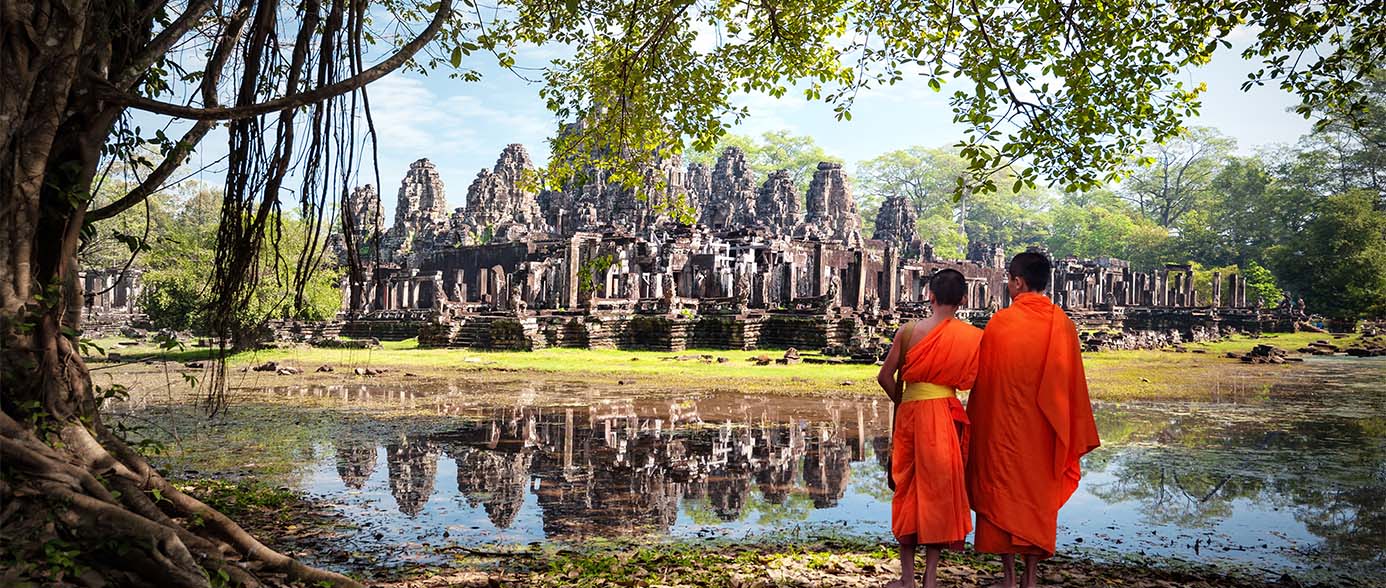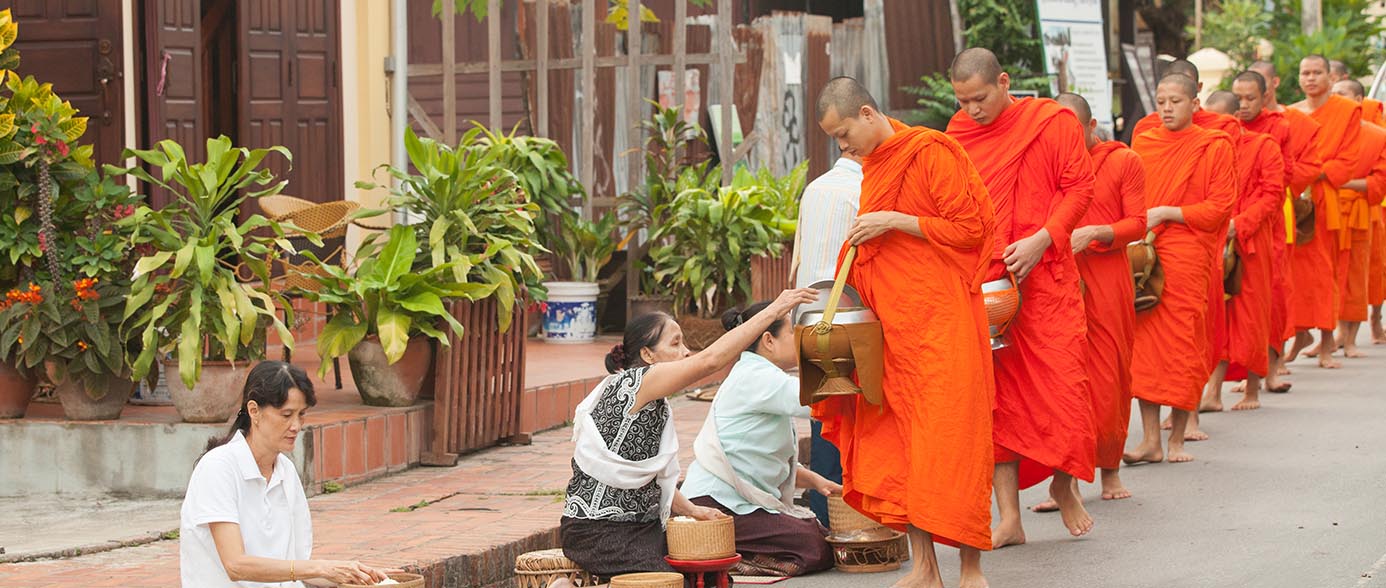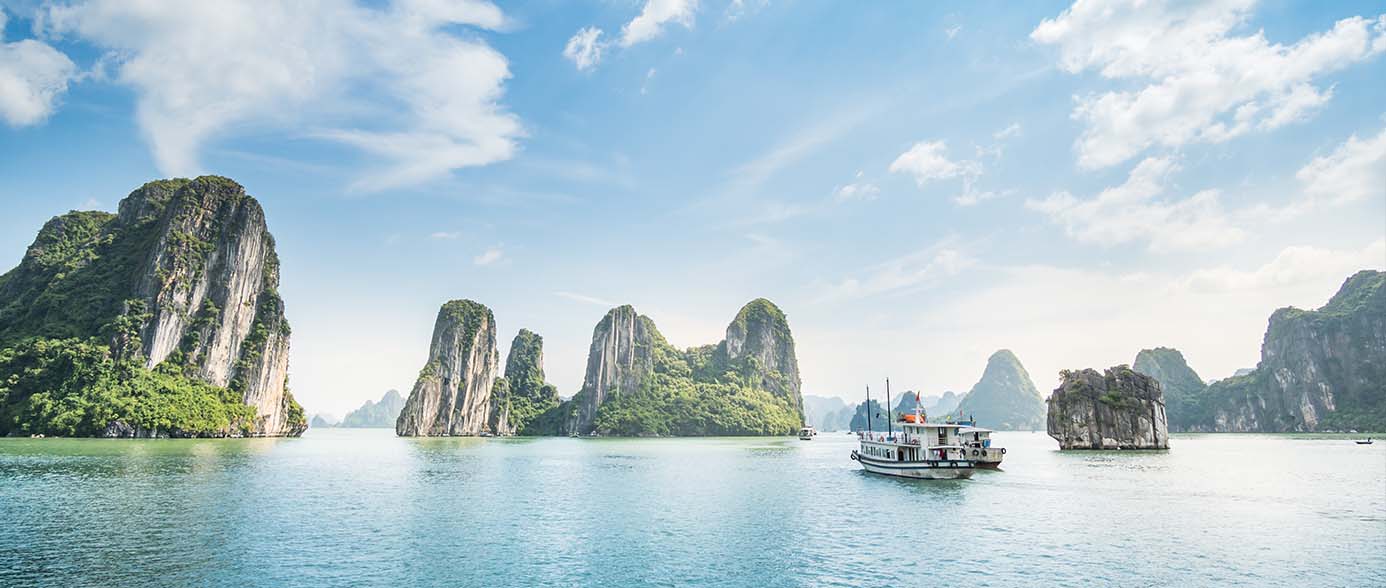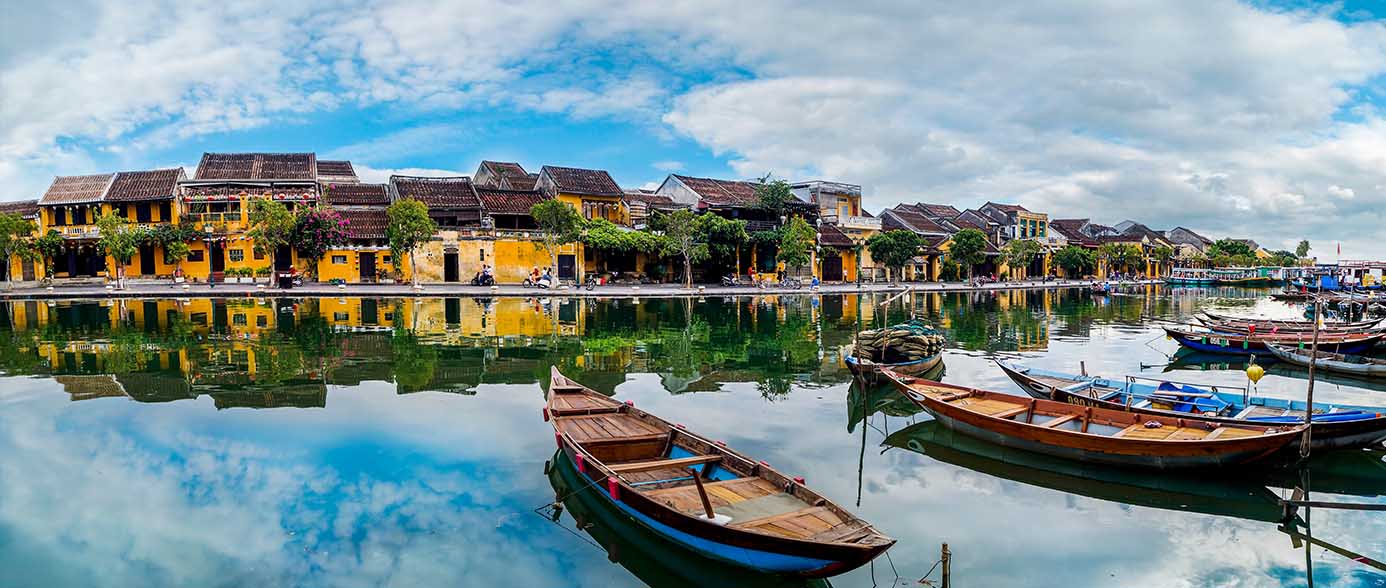TOUR OVERVIEW
15 Days
SIEM REAP – LUANG PRABANG – HANOI – HALONG – THANH HOA – DONG HOI – HUE – HOIAN – MY SON
Vietnam, Cambodia, Laos
Discover a part of history hidden from the world, the Indochina region (Cambodia, Laos and Vietnam) that takes you on a trip where past and present co-exist in harmony. Indochina contains a lot of historical and cultural values with the harmonious cohesion, a numerous of sites and cultures have been recognized by the UNESCO. This trip is specially designed to let you explore the World Heritage Sites without leaving the other highlights of these countries behind.
-
Upon arrival at Siem Reap airport- the gateways to the famous Angkor Wat- the World Heritage Site, greeting then private transfer to hotel. Enjoy the remainder of day at leisure for a well-earned rest after the journey on the airplane.
Overnight in Siem Reap. -
Today, we visit the Angkor Wat, one of the modern wonders of the world. Be amazed by the sheer size of the temple and learn how the Khmer Empire prospered between the 9th and 13th centuries, around the time when Angkor Wat was built. Stroll through the intricately carved hallways that show hundreds of fine carvings and discover small shrines still in use today by the local people.
Visit the Angkor Thom, the ancient royal city of Khmer Empire with its centre piece; the Bayon temple. As approaching, we will notice the enigmatic faces of former King Jayavarman VII looking into every direction. The guide will take us to the Terrace of the Elephants, which served as a platform from where the King could welcome back his victorious army and the Terrace of the Leper King, which holds detailed carvings winding along a narrow passage way that leads to the Baphuon complex.
Continue to Ta Prohm- the Tomb Raider. This beautiful temple is overgrown with fig trees, giving a haunting yet exotic atmosphere. The magnificent roots of the trees have merged over the centuries with the temple’s huge stone blocks, emphasizing a ‘forgotten city’ feeling. The magnificent roots of the trees have merged over the centuries with the temple’s huge stone blocks, emphasizing a ‘lost city’ feeling. Return to your hotel for refreshment.
During the sunset, we visit Pre Rup Temple, meaning “Turning The Body”. This Hindu temple was built as the state temple of Khmer king Rajendravarman, and dedicated in 961 or early 962. It is a temple mountain of combined brick, laterite and sandstone construction. This reflects the common belief among Cambodians that funerals were conducted at the temple, with the ashes of the body being ritually rotated in different directions as the service progressed.
Leisure and overnight in Siem Reap. -
Early morning departure from downtown Siem Reap on a scenic drive to one of the most remote province of Cambodia, which used to be a burdensome journey with bumpy roads but today it is easier to access. The magical temple of Preah Vihear gave its name to the province in which it is now located. Lying on a disputed area of land right on the border, the temple has been the subject of debate within Cambodia and Thailand since the late 19th Century. Upon arrival, you will be transferred by an enclosed pick-up truck up the steep track to the temple at the top. Start exploring the ‘sacred sanctuary’ while listening to your guide sharing a little bit more about the history of this incredibly inspiring temple. Recognized as the UNESCO World Heritage site since 2008, the Preah Vihear Temple is located in the heart of a plateau that dominates the plain of Cambodia. The complex has been well-preserved and adapted to the natural environment and religious function. Notice a system of pavements and staircases on an 800-meter long axis which is an outstanding architecture, typical of Khmer architecture in terms of decoration, and connection to surrounding landscapes.
-
The Apsara dance is a century-old Khmer dance that plays a remarkable role in Cambodia culture. In Hindu mythology, Apsaras were beautiful female creatures who descended from heaven to entertain gods and kings with their dancing. Classified by UNESCO as one of the great intangible cultural assets of the world, this traditional dance is meaningful in many ways as it constitutes a link between the different religions prominent in Cambodia, including Animism, Hinduism, and Buddhism.
This morning, visit a local school of art and take in the ancient art of Apsara performance. Home to about 70 talented children in various Khmer Arts such as classical dance, folk dance, Pin Peat Music, and Yike drama, the school aims to maintain, develop Khmer culture and introduce its beauty to international friends. You will have a great opportunity to learn how young adults are trained in this ancient art by enjoying a guided tour around the school to engage in casual talk with the trainers and students. Learn some special techniques under their helpful instruction and explanation before watching a professional and mesmerizing Apsara dance performance staged by passionate students. Notice the symbolic and elegant finger gestures and the ornate silk costumes should appear in the wall carvings of the Angkor temple.
Boarding an afternoon flight to Luang Prabang.
Luang Prabang is perhaps the best-preserved traditional city in Southeast Asia. This remarkable town has been recognized by the UNESCO and inscribed on the World Heritage List since 1995. The tranquility and charm of this town with its splendid natural scenery and cultural sights make it one of the most delightful places to visit in Laos.
Landing in Luang Prabang, you will be met by our guide and transferred to your hotel for check-in. Leisure and overnight in Luang Prabang.
-
Meet friendly locals and have interesting experiences of Laos ethnic minorities. Start with a visit to the Traditional Arts and Ethnology Centre, a private museum devoted to Lao ethnography, provides an overview of the four main ethno linguistic families (Austroasiatic, Hmong-Yao, Tai-Kadai, Sino-Tibetan) and their distribution in the country. Traditional clothing and headdresses, religious artefacts, photography and handicrafts are also on display.
In the afternoon, we visit the National Museum at the former Royal Palace, the impressive stupa of Wat Mai and the magnificent Wat Xieng Thong. Then we climb up to the top of Phousi Mount for an enjoyable exploration of the sacred, gilded stupa as well as a beautiful sunset view of the city and the Mekong River. From there, we explore Street Night Bazaar, where the lovely collection and handmade textile by local and hill tribe people surrounding Luang Prabang could be found.
Overnight in Luang Prabang. -
For early risers, there is a very special dawn visit to watch the monks collecting the alms. As the sun begins to rise, long lines of orange-robed monks leave their pagodas and walk barefoot down the streets collecting offerings from Luang Prabang residents. It is a beautiful, serene ceremony that highlights the spiritualism of the Laos people. Visit Morning Market where you can find all ingredients for local food. Return to your hotel for breakfast and rest.
After breakfast, you board a cruise upstream on the Mekong River to visit the mysterious of Pak Ou Caves, crammed with thousands of gold lacquered Buddha statues of various shapes and sizes.
Late afternoon, travel by tuk-tuk to a local house. You will be warmly welcomed by your host before taking part in a Baci ceremony where you will have white cotton strings ties around your wrist for good luck! Baci is a ceremony to celebrate a special event, whether a marriage, a homecoming, a welcome, a birth, or one of the annual festivals. The Baci ceremony can take place any day of the week and all year long, preferably before noon or before sunset. The term more commonly used is su kwan, which means “calling of the soul”. After that, enjoy the authentic home cooked Laos cuisines, chat with the locals and then return to your hotel. -
This morning, we visit the Ock Pop Tok Living Crafts center to learn more about the fascinating world of Lao textiles and handicrafts in our beautiful gardens on the banks of the Mekong River.
Later, we transfer to the airport for a short afternoon flight to Hanoi, the capital city of Vietnam.
Upon arrival at Noi Bai international airport in Ha Noi, welcomed by our guide and transferred to your hotel to check in.
Leisure and overnight stay in Ha Noi. -
This morning, we visit the Imperial Citadel of Thang Long whose Central Sector was inscribed in UNESCO's World Heritage Site in 2010. In the 11th Century, The Thang Long Imperial Citadel was built on the remains of a Chinese Fortress dating from the 7th century by the Ly Dynasty to remark the independence of the Dai Viet. The outstanding value of this heritage site is noted by its long cultural history during 13 centuries serving as the capital of different feudal dynasties.
Following, we visit Ho Chi Minh complex including the Mausoleum (view from outside only), Ba Dinh Square, Ho Chi Minh’s stilts house, Presidential Palace (see from outside).
We also visit Van Mieu - Quoc Tu Giam (Temple of Literature & Vietnam’s first university). Constructed in 11th century, the gardens and well-preserved architecture offer a relaxing glimpse into Vietnam's past. Stop at Hoa Lo Prison - was built in Ha Noi by the French, in dates ranging from 1886 – 1889 to 1898 to 1901, when Vietnam was still part of French Indochina. The French called the prison Maison Centrale - a traditional euphemism to denote prisons in France.
Overnight stay in Ha Noi. -
After breakfast, we depart for Ha Long Bay – designated a UNESCO World Natural Heritage Site for its limestone rock formations, is home to about thousands of isles and islets of different shapes and sizes, creating a truly breath-taking seascape on the Gulf of Tonkin. Ha Long Bay is also attractive for beautiful beaches on the small islands.
Upon arrival at the port, check in procedure. Enjoy welcome drink on board before having lunch. Relaxing time while the boat is cruising through many stone islets, floating villages, small beaches. Visit a floating fishing village, talk and meet with local villagers prior to your swimming or free time at your own on the sundeck. Dinner would be ready at the time the boat anchors off at a quiet designated overnight area.
Overnight stay on board in Ha Long Bay.
Note: Itinerary is subject to change without prior notice according to weather conditions or local administration regulations. -
Awake early and join the Tai Chi session on the sundeck or enjoy the breath-taking views of the bay while the boat cruises leisurely in Ha Long Bay. Cave excursion after breakfast. Then go back to your cabin for freshen up and check out of your room. Enjoy brunch on board while cruising toward the pier, and disembarking around noon time.
Transfer back to Ha Noi where you will board the SE5 train departing for Thanh Hoa at 15:20
Arriving in Thanh Hoa at 19:00, we transfer to hotel for checking in.
Overnight in Thanh Hoa. -
After breakfast, we transfer to visit the citadel of the Ho Dynasty. This solid citadel was built in 14th century according to the Feng Shui principles, with unique stone architecture, very valuable and rare in Vietnam. It is the only remaining stone rampart in Southeast Asia and one of the very few remaining ones in the world. There are many legends about this rampart such as how it was built or why the capital was move from Thang Long to here right when the construction was completed. In 2011, UNESCO has recognized the Ho Dynasty Citadel as a World Cultural Heritage because of its unique cultural, historical and construction values.
Later, we board the train SE5, departing from Thanh Hoa Train Station at 12:37 and arriving in Dong Hoi train station at 19:22. Upon arrival at Dong Hoi, we transfer to our hotel for checking in. Leisure and overnight in Dong Hoi city. -
After breakfast, we transfer to visit the Phong Nha-Ke Bang National Park. Designated a UNESCO World Heritage Site in 2003, this remarkable park contains the oldest karst mountains in Asia, formed approximately 400 million years ago. The park is covered mostly with tropical rainforest, offering many significant geomorphic features including underground rivers, dendritic caves, dry caves, suspended caves, and terraced caves. Home to various interesting flora many of which are hardly found elsewhere, the park provides to nature and adventure lovers the countless outdoor activities: cycling, kayaking, boating, cave exploring, mountain climbing, forest trekking. Arrive at the garden, visit Exhibition House for an overview of the forest’s valuable natural resources and its unique environment. Visit the spectacular Paradise Cave, considered as one of the largest complexes of caves in the world. Surrounded by forested karst peaks, this remarkable cave system features cathedral-like spaces with colossal stalagmites and glimmering stalactites, each part of the cave opens into a different space, with giant naturally formed silhouettes of unicorns, lions, and dragons.
This afternoon, enjoy a leisure boat trip on Son River to Phong Nha Cave, one of the most impressive and beautiful cave with many fascinating rock formations with imaginative names such as The Lion, Fairy Caves.eg. The more illusory the stalactites and stalagmites look as they glitter when the right light shined on them. After the visit, transfer back to your hotel.
Leisure and overnight in Quang Binh. -
This morning, we set off for a long but pleasant drive to Hue, the former Imperial capital, is a tranquil and peaceful city with the magnificent architecture of its citadel, palaces, royal tombs, pagodas and temples, built under the Nguyen dynasty on the banks of the Perfume River.
Checking in our hotel for rest upon arrival in the early afternoon.
Later, enjoy a boat trip on Huong River, or better known as the perfume river. The boat drops us off at the beautiful Thien Mu Pagoda which is also home to many young people who want to try out and learn from life as a monk. Then continue your slow journey on the Perfume River heading to the royal tomb of King Minh Mang that represents the perfect harmony of nature and architecture. Perched in a tranquil and picturesque forest setting surrounded by frangipani and lotus blossoms, the tomb is a great feature of Minh Mang’s characteristics. Minh Mang was the second king of Nguyen dynasty and also known for his isolationist and conservative Confucian policies.
Overnight stay in Hue. -
This morning, we explore the Imperial Citadel at the centre of the Complex of Hue Monuments inscribed by UNESCO as a World Heritage site. Enter through the towering main gate to observe the magnificent architecture and gardens while your guide explains the events and the intrigue surrounding the former royal court. Some sections suffered the most extensive damage during the Vietnam War, but most of them are incredibly well-preserved. Wind your way to the Royal Tu Duc tomb, a peaceful resting place enclosed by walls, featuring pine woods and a lakeside pavilion with lotus blossoms where the emperor stayed in the past for fishing, listening to music and writing poetry. The emperor used it as a second residence, where he indulged in extravagant 50-course meals of incredible delicacies.
After exploring the tomb, drive back to downtown Hue with a stop en route at a family-run workshop to learn how incense stick is made.
This afternoon, instead of showing you another tomb, we will show you a special place: Cat Tuong Quan, the unique Zen House in Hue. Cat Tuong Quan Zen House, tranquil living place, elegant lifestyle with all members, who have not served visitors in professional manner yet, but they show their diligence and sincerity. The owner of Tuong Quan Zen House believes that the landscape and the people at the Zen House will help visitors find the peace and happiness of body and mind. Enjoy a short introduction of “Nha Ruong” - a typical architecture in Hue and the spiritual meaning of Cat Tuong Quan, then take sightseeing by the host and taking photos at your own leisure. After the site visiting, seat down and enjoy brown rice tea and dried ginger jam.
Leisure and overnight in Hue. -
Take a land journey to Hue Imperial City via the cloudy Hai Van Pass. From the top of the cloudy Hai Van Pass to grab your own Vietnam central coast panoramic view.
In the afternoon, explore Hoi An Ancient Town, including the rich architectural fusion of 300 years old Chinese temple, 400 years old Japanese covered bridge, 200 years old Vietnamese former merchant home influences by visiting Hoi An narrow streets where each house façade is dangled with lanterns. This charming ancient town has become a UNESCO-listed site since 1999.
The evening is free and one of our suggestions is to join the unique activity for public at the outdoor stage along the Hoai River nightly: Bai Choi singing, a folk music genre practised in Viet Nam’s central region, has been added to the UNESCO Representative List of the Intangible Cultural Heritage of Humanity. First learn the rule of the game and you are invited to join the performance or just being an audience.
Overnight stay in Hoi An. -
The UNESCO World Heritage Centre of My Son is a remarkable trace of Champa structural remains. My Son used to be the prosperous capital of Champa civilization, ruled in Central Vietnam from 2nd to 13th Century.
Today, drive 40km southwest Hoi An to My Son Sanctuary, considered to be in the same league as some of Southeast Asia's greatest archaeological sites. The towers were built from 9th to 13th Century. Most of the temples were dedicated to Champa Kings and also served as a burial place for Cham monarchs.
Stroll around the temple complex, rediscovered in the late 19th century where you will have a great opportunity to learn about the fascinating Cham culture, architecture, and civilization. The guide will also explain to you about ties to Hindu divinities, namely Shiva, known as the founder and protector of Champa’s dynasties.
Followed by the My Son complex is a culture talk about Cham civilization. Scattered across the central coast and plains of Vietnam are the ruins of the ancient kingdom of Champa. Lasting for over a thousand years, Cham civilization has thrived in the lush, fertile valleys and stunning bays of Central Vietnam. We pay the visit to the private Cham Culture Space showcasing daily utensils, objects, instruments, and costumes of the Cham people and then participate in a casual talk with an independent writer, artist, and researcher, who specializes in the Cham culture and contributes to preserve and introduce this unique culture to international friends. Enjoy our lunch here before saying goodbye to this special host to head back to Hoian.
The remainder of day is at leisure. Overnight in Hoian. -
Breakfast and leisure. At a good time, we transfer to the airport for our departure flight.----------- End of service ----------







